2015版环境管理体系 要求及使用指南资料
- 格式:doc
- 大小:68.18 KB
- 文档页数:14

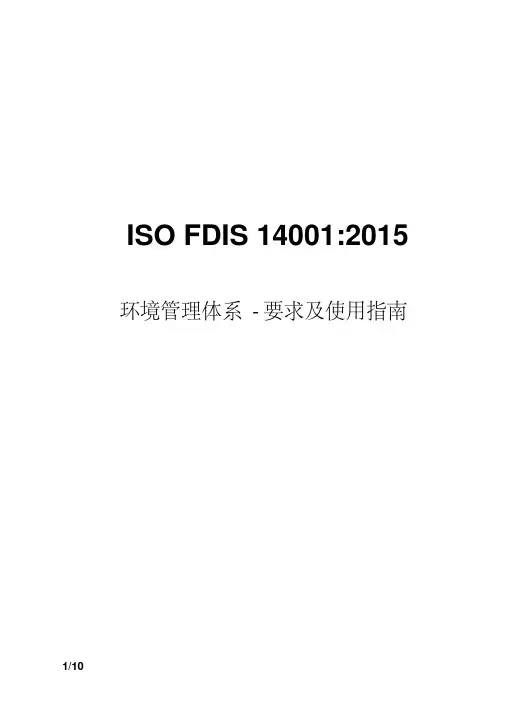
ISO FDIS 14001:2015 环境管理体系-要求及使用指南ISO14001:2015 FDIS中文稿(节选)——新旧版本管理体系模式的变化:2004版本管理体系模式北京华夏健峰企业管理咨询ISO14001:2004 EMS 运行模式PDCA4.6管理评审4.5.1 监测和测量4.5.2 合规性评价4.5.3 不符合,纠正及预防措施4.5.4 记录控制4.5.5 内部审核4.3.1 环境因素4.3.2 法律及其它要求4.3.3 目标指标和方案4.4.1 资源、作用、职责和权限4.4.2 能力、培训和意识4.4.3 信息交流4.4.4 文件4.4.5 文件控制4.4.6 运行控制4.4.7应急准备和响应A PC D4.2 环境方针2015版本的管理体系模式北京华夏健峰企业管理咨询ISO14001:2015 --PDCA领导力(5)策划(6)绩效评价(9)改进(10)支持与运作(7、8)外部与内部的问题(4.1))相关方需求与期待(4.2)环境管理体系的成果3 术语定义(部分)3.15 生命周期从获取原材料,或者利用自然资源加工到废弃处理的连续的相互关联的产品系统。
注:生命周期包括活动,产品和服务,既可以包括采购的产品和服务,也可以包括产品废弃处理和运输服务,如:设计、制造、运输、包装、最终使用和处置。
3.18 风险不确定性对目标的影响注:——影响是对预期的偏离—积极或消极。
——不确定性是指对事件、其后果或可能性的认识或了解方面的信息的缺乏或不完整的状态。
——风险通常以潜在事件和后果,或他们的组合来描述。
——风险通常以事件的后果(包括环境的变化)和发生可能。
3.5 相关方能影响某项决定或活动或被其影响的,或感知到自身将受其影响的个人或组织。
注:——相关方可能包括关注或受组织环境绩效影响的个人或团体。
——“感知自身受影响”指来自与已知组织。
——相关方可能包括客户、团体、供应商、监管者、非政府组织、投资商、员工。
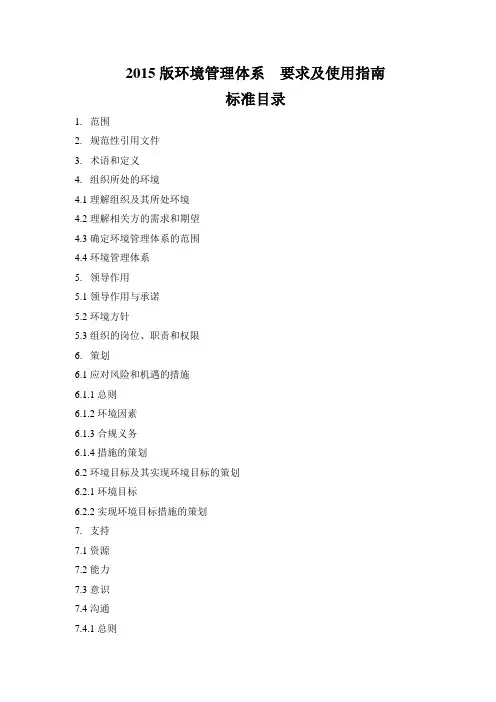
2015版环境管理体系要求及使用指南标准目录1.范围2.规范性引用文件3.术语和定义4.组织所处的环境4.1理解组织及其所处环境4.2理解相关方的需求和期望4.3确定环境管理体系的范围4.4环境管理体系5.领导作用5.1领导作用与承诺5.2环境方针5.3组织的岗位、职责和权限6.策划6.1应对风险和机遇的措施6.1.1总则6.1.2环境因素6.1.3合规义务6.1.4措施的策划6.2环境目标及其实现环境目标的策划6.2.1环境目标6.2.2实现环境目标措施的策划7.支持7.1资源7.2能力7.3意识7.4沟通7.4.1总则7.4.2内部沟通7.4.3外部沟通7.5形成文件的信息7.5.1总则7.5.2创建和更新7.5.3形成文件的信息的控制8.运行8.1运行策划和控制8.2应急准备和响应9.绩效评价9.1监视、测量、分析和评价9.1.1总则9.1.2合规性评价9.2内部审核9.2.1总则9.2.2内部审核方案9.3管理评审10.改进10.1总则10.2不符合与纠正措施10.3持续改进4组织环境4.1理解组织及其环境组织应确定与其目标相关、并影响其实现环境管理体系预期结果的能力的外部和内部因素。
这些因素应包括受组织影响的或能够影响组织的环境条件。
4.2理解相关方的需求和期望组织应确定:a)与环境管理体系有关的相关方;b)这些相关方的有关需求和期望(即要求);c)这些需求和期望中哪些会成为其合规义务。
4.3确定环境管理体系的范围组织应确定环境管理体系的边界和适用性,以界定其范围。
确定范围时组织应考虑:a) 4.1中提及的外部和内部因素;b) 4.2中提及的合规义务;c) 组织的单元、职能和物理边界;d) 组织的活动、产品和服务;e) 组织实施控制与施加影响的权限和能力。
范围一经确定,在该范围内组织的所有活动、产品和服务均须纳入环境管理体系。
应保持体系范围的形成文件的信息,并可为相关方获取。
4.4环境管理体系为实现包括提升环境绩效在内的预期结果,组织应根据本标准的要求建立实施、保持并持续改进环境管理体系,包括所需的过程及其相互作用。

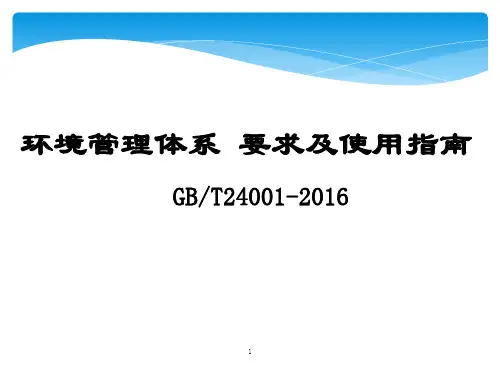

Table of Contents1Introduction ________________________________________________________________________________________________ 4 2References __________________________________________________________________________________________________ 5 3Definitions __________________________________________________________________________________________________ 5 4About Our Organization ___________________________________________________________________________________ 6 4.1Organizational Context _______________________________________________________________________________ 6 4.2Relevant Interested Parties ___________________________________________________________________________ 6 4.3Management System Scope __________________________________________________________________________ 7 4.4Management System Processes ______________________________________________________________________ 8 5Leadership & Governance _______________________________________________________________________________ 10 5.1Leadership & Commitment _________________________________________________________________________ 10 5.2Environmental Policy ________________________________________________________________________________ 11 5.3Role, Responsibilities & Authorities _______________________________________________________________ 135.3.1 Top Management _________________________________________________________________________________ 135.3.2 Environment & Sustainability Manager __________________________________________________________ 135.3.3 Environment & Sustainability Coordinator _______________________________________________________ 145.3.4 Department Managers ____________________________________________________________________________ 145.3.5 Employees ________________________________________________________________________________________ 14 6Management System Planning __________________________________________________________________________ 156.1Addressing Risks & Opportunities _________________________________________________________________ 156.1.1 General ____________________________________________________________________________________________ 156.1.2 Environmental Aspects____________________________________________________________________________ 166.1.3 Compliance Obligations __________________________________________________________________________ 176.1.4 Planning Action ___________________________________________________________________________________ 18 6.2EMS Objectives ______________________________________________________________________________________ 196.2.1 Environmental Objectives _________________________________________________________________________ 196.2.2 Planning Actions to Achieve Environmental Objectives __________________________________________ 20 7Support____________________________________________________________________________________________________ 217.1Resources ____________________________________________________________________________________________ 21 7.2Competence __________________________________________________________________________________________ 22 7.3Awareness ____________________________________________________________________________________________ 23 7.4Communication ______________________________________________________________________________________ 237.4.1 General ____________________________________________________________________________________________ 237.4.2 Internal Communication __________________________________________________________________________ 237.4.3 External Communication __________________________________________________________________________ 247.5Documented Information ___________________________________________________________________________ 247.5.1 Management System Documents ________________________________________________________________ 247.5.2 Creating & Updating______________________________________________________________________________ 257.5.3 Controlling Documented Information ____________________________________________________________ 25 8Operation _________________________________________________________________________________________________ 26 8.1Operational Planning & Control ___________________________________________________________________ 26 8.2Environmental Emergency Situations ______________________________________________________________ 27 9Performance Evaluation _________________________________________________________________________________ 29 9.1Monitoring, Measurement, Analysis & Evaluation _______________________________________________ 299.1.1 General ____________________________________________________________________________________________ 299.1.2 Evaluation of Compliance _________________________________________________________________________ 30 9.2Internal Audit ________________________________________________________________________________________ 309.2.1 General ____________________________________________________________________________________________ 309.2.2 Internal Audit Programme ________________________________________________________________________ 31 9.3Management Review ________________________________________________________________________________ 319.3.1 General ____________________________________________________________________________________________ 319.3.2 Inputs _____________________________________________________________________________________________ 329.3.3 Outputs ___________________________________________________________________________________________ 32 10Improvement ___________________________________________________________________________________________ 34 10.1General _____________________________________________________________________________________________ 34 10.2Non-conformity & Corrective Action ___________________________________________________________ 34 10.3Improvement ______________________________________________________________________________________ 35 Appendices ____________________________________________________________________________________________________ 37 A.1Correlation Matrix ___________________________________________________________________________________ 37 A.2EMS Process Map ____________________________________________________________________________________ 39 A.3Organization Chart __________________________________________________________________________________ 404About Our Organization4.1Organizational ContextYour organization is committed to defining our position in the marketplace and understanding how relevant factors arising from internal and external issues influence our strategic direction, our organizational context, or the ability of our EMS to achieve its intended outcomes. Such issues include factors that are capable of being affected by, or capable of affecting our organization. Broadly, these issues are defined as:1.Internal issues– conditions related to our organizational activities, products, services, strategicdirection, culture, people, knowledge, processes and systems. Using SWOT analysis provides ourorganization with framework for reviewing and evaluating our strategies, and the position anddirection of our organization, business propositions and other ideas;2.External issues– conditions related to cultural, social, political, legal, regulatory, financial,technological, economic, competition at local, national or international levels. Using PESTLE analysis provides our organization with framework for measuring our market and growth potential according to external political, economic, social, technological, legal and environmental factors;3.Environmental issues– conditions related to climate, air quality water quality, land use, naturalresource availability or biodiversity that can either affect our organization’s purpose, or be affected by our environmental aspects and impacts, which your organization must manage.Although we acknowledge that ISO 14001:2015 does not require our organizational context to be maintained as documented information, we maintain and retain; in addition to this document, the following documented information that describes our organizational context:1.SWOT Analysis Templates for internal issues;2.PESTLE Analysis Templates for external issues;3.Environmental Aspects & Impacts Registers for environmental issues;4.Business plans, strategy documents, operational procedures;5.Analysis of technology and competitors;6.Technical reports from experts and/or consultants;7.Minutes of meetings, process maps and reports, etc.Your organization and collates and assesses information about these influential factors to ensure that a continual understanding of the relevance of each factor is derived and maintained. To facilitate the understanding of our context, we regularly consider issues that influence our business during management review meetings, the results of which are conveyed via minutes and business planning documents.The output from this activity is evident as an input to determining the scope of our EMS (Refer to Section 4.3) and its processes (Refer to Section 4.4), as well as, the consideration of risks and opportunities that may affect our EMS, and the resulting actions that we take to address them (Refer to Section 6.1).4.2Relevant Interested PartiesYour organization recognizes that we have a unique set of interested parties whose needs and expectations (requirements) change and develop over time. Only a limited set of requirements are relevant to our EMS, and which are considered and managed as a compliance obligation. The criteria for y our organization’s compliance obligations include the following parameters:1.All relevant legal requirements;2. All corporate requirements imposedby upper levels of our organization; 3. All relevant requirements of relevantinterested parties that ourorganization decides to comply with, these may either be contractual (customers) or voluntary(environmental commitments). By asking ‘how the interested party (or their requirements) might affect our organization’s ability to achieve the intended outcomes of our environmental management system ?’ we are able to determine and document the relevant interested party requirements. Although not specifically required by ISO 14001:2015, your organization maintains an Interested Party Matrix that aligns a list of relevantinterestedpartiestotheircorresponding needs and expectations; with an indication of which of these has beenaccepted by our organization as a compliance obligation. Such needs and expectations, and whether they are critical to the success of our EMS, broadly include the examples shown in the table below.The outputs from this process are typically used to inform the following sections and processes of the EMS:1. 4.3 Management system scope;2. 4.4 Management system processes;3. 6.1.1 Actions to address risk and opportunities that affect the EMS;4. 6.1.2 Environmental aspect and impacts;5.6.1.3 Compliance obligations; 6.7.4 Communications.4.3 Management System ScopeBased on the scope of our activities described in Section 1 - Introduction and the analysis of the issues and requirements identified in Sections 4.1 and 4.2, your organization has established the scope of our environmental management system in order the implement the objectives and policies that are relevant to our context, physical and organizational boundaries, product life-cycles and any interested parties.Figure 2: Types of Interested PartyYour organization is able to exert authority and differing levels of control and influence over our activities, as they relate to our products and services, as performed at our facilities. The functional and organizational boundaries for the different physical locations (where applicable) and the level of control and influence are summarised below:In order for our EMS to be robust, all the activities, products and services undertaken by your organization are included with in the scope of the EMS. In this way, we are able to control and influence our activities, products and services.The scope of this document describes our EMS, delineates authorities, inter-relationships and responsibilities of process owners and personnel that operate within management system and the sequence and interaction of our processes. Conformance to ISO 14001:2015 has been verified utilizing a formal assessment and review process undertaken by <insert the name of your Registrar>.Although we recognize that ISO 14001:2015 does not require a formal manual, we have decided to retain and update our EMS manual, as our employees, customers, suppliers and other stakeholders perceive it to add value to our operations.4.4Management System ProcessesYour organization’s EMS and its processes are designed around the principle of continual improvement and adoption of the process approach methodology, using the Plan, Do, Check and Act cycle. The EMS manual generally follows the layout and high-level structure of ISO 14001:2015.In order to achieve our intended outcomes,your organization has implemented an environmental management system; based upon sound management principles, which is integrated with the key day-to-day management activities that our organization undertakes. It also exists as part of a larger strategy to establish, document and communicate our processes, their interactions, our policies and objectives; whilst satisfying the requirements of ISO 14001:2015. EMS processes are defined to address:1.Supplier, manufacturer, internal and external issues;2.Material, resource and energy usage;3.Waste and emissions generation;4.Design, operation, production and logistics;5.Activities, products, and services;6.Customers and end-users.An environmental review is conducted every 3 years ahead of re-certification to determine any changes to our organization which may affect the intended outcomes of our EMS. In addition, to meet the requirements of ISO14001:2015, your organization also determines any changes to our internal and external context inwhich we operate (Refer to Section 4.1) and the changing needs and expectations of interested parties (Refer to Section 4.2).Process controls are defined by tools and documents, such as; documented procedures, process maps, flow diagrams, matrices, schedules, and charts, etc. Refer to the EMS Process Map located in Appendix A.2 that shows the processes and the interactions that allow our organization to establish, implement, maintain and continually improve our management system.The effectiveness and integration of the each process and its subsequent output is measured and evaluated through regular internal audits, inspections and data analysis. The monitoring of key performance indicators (KPIs) which are linked to our objectives are used to measure and communicate process performance. This approach allows Top management to regularly review the EMS to ensure its ongoing integration with in the business.As part of the decision making process, we use trends and statistical data related to non-conformities, environmental aspects, obligations, targets, objectives and corrective actions, as well as, monitoring and measurement results, audit results and compliance data, to ensure that objective, and responsible management decisions are made.AppendicesA.1 Correlation MatrixThis section provides a matrix to correlate the requirements of ISO 14001:2015 against the relevant sections in this document and should be used to determine where the new and amended clauses are located.A.2 EMS Process MapEnergyMaterials Finance PeopleRestrictions OpportunitiesSpecificationVolumeProducts Waste Emissions Capacity to reduce wasteCapacity to influence supplyInsert your company’s name or logo. ISO 14001:2015EMS Manual Page 40 of 40A.3 Organization Chart<Insert your organization chart here>。
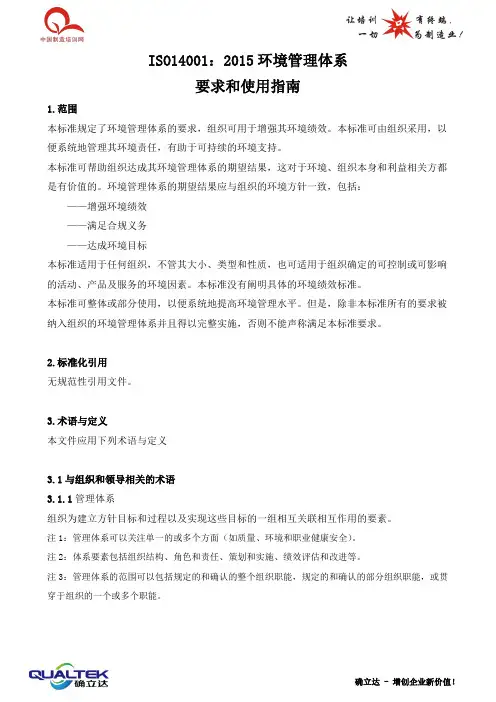
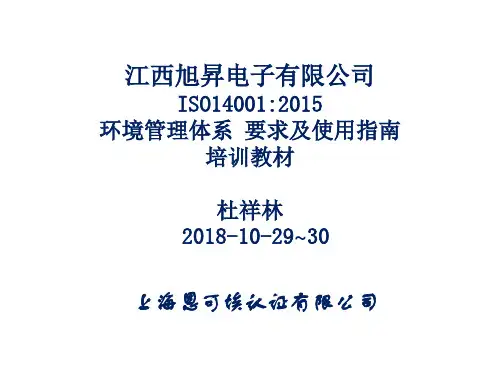
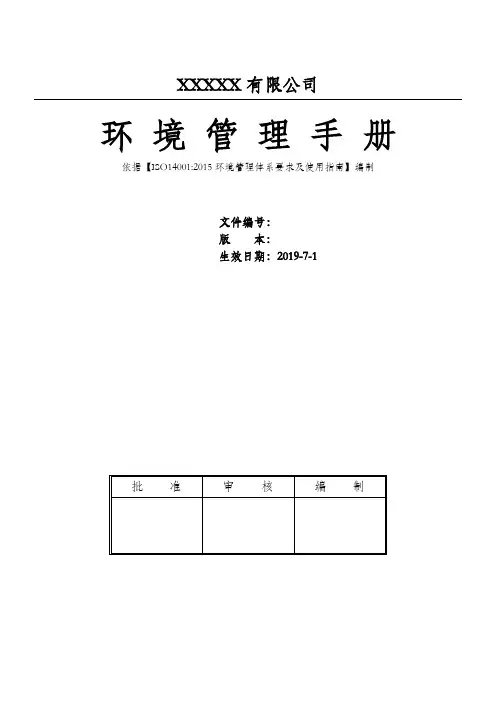
XXXXX有限公司环境管理手册依据【ISO14001:2015环境管理体系要求及使用指南】编制文件编号:版本:生效日期:2019-7-1批准审核编制目录章节号名称页码0.1 环境管理手册目录0.2 手册修改记录0.3 环境管理手册发布令0.4 任命书0.5 XXX有限公司简介1.0 目的和适用范围2.0 引用标准3.0 术语和定义4.0 公司所处的环境5.0 领导作用5.1 领导作用和承诺5.2 环境方针5.3 岗位、职责和权限6.0 策划6.1 应对风险和机遇的措施6.1.1 总则6.1.2 环境因素6.1.3 合规义务6.1.4 措施的策划章节号名称页码6.2 环境目标及其实施的策划7.0 支持7.1 资源7.2 能力和意识7.3 信息交流7.4 文件化信息8.0 运行8.1 运行策划和控制8.2 应急准备和响应9.0 绩效评价9.1 监视、测量、分析和评价9.2 内部审核9.3 管理评审10.0 改进/ 附件一:XXX有限公司环境管理手册、程序文件与权责一览表/ 附件二: XXX有限公司ISO14001:2015环境管理体系职能分配表/ 附件三: XXX有限公司ISO14001:2015环境管理体系组织机构图/ 附件四: XXX有限公司厂区图0.3 发布令:环境手册发布令本公司所推行的“ISO14001:2015ISO14001:2015环境管理体系”是以文件为基础的ISO14001:2015环境管理体系;为了使公司的ISO14001:2015环境管理体系文件的制定有依据,公司现制定«环境管理手册»予以发布。
根据GB/T24001-2015 idt ISO14001:2015《ISO14001:2015环境管理体系—要求及使用指南》标准,由管理者代表组织编制并审核,总经理批准发布,本手册是在充分考察了本公司具体情况的基础上,经过反复讨论,研究而制定出来的。
它明确了公司的环境方针、环境目标,确定了组织结构,规定了ISO14001:2015环境管理体系所应用的ISO14001:2015国际标准的要求.。
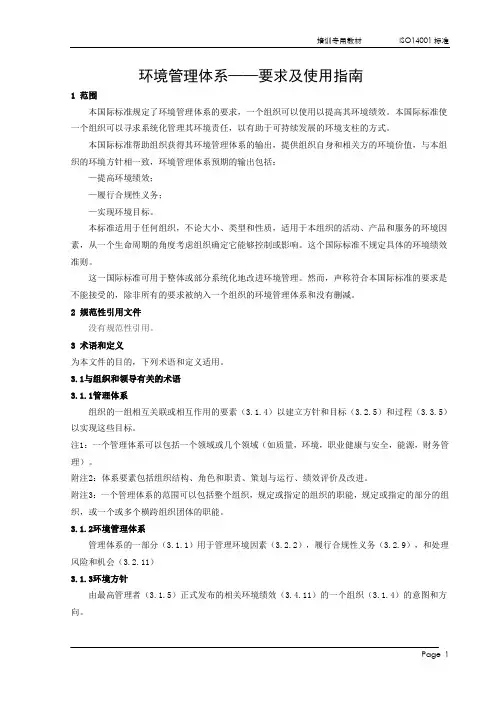
环境管理体系——要求及使用指南1 范围本国际标准规定了环境管理体系的要求,一个组织可以使用以提高其环境绩效。
本国际标准使一个组织可以寻求系统化管理其环境责任,以有助于可持续发展的环境支柱的方式。
本国际标准帮助组织获得其环境管理体系的输出,提供组织自身和相关方的环境价值,与本组织的环境方针相一致,环境管理体系预期的输出包括:—提高环境绩效;—履行合规性义务;—实现环境目标。
本标准适用于任何组织,不论大小、类型和性质,适用于本组织的活动、产品和服务的环境因素,从一个生命周期的角度考虑组织确定它能够控制或影响。
这个国际标准不规定具体的环境绩效准则。
这一国际标准可用于整体或部分系统化地改进环境管理。
然而,声称符合本国际标准的要求是不能接受的,除非所有的要求被纳入一个组织的环境管理体系和没有删减。
2 规范性引用文件没有规范性引用。
3 术语和定义为本文件的目的,下列术语和定义适用。
3.1与组织和领导有关的术语3.1.1管理体系组织的一组相互关联或相互作用的要素(3.1.4)以建立方针和目标(3.2.5)和过程(3.3.5)以实现这些目标。
注1:一个管理体系可以包括一个领域或几个领域(如质量,环境,职业健康与安全,能源,财务管理)。
附注2:体系要素包括组织结构、角色和职责、策划与运行、绩效评价及改进。
附注3:一个管理体系的范围可以包括整个组织,规定或指定的组织的职能,规定或指定的部分的组织,或一个或多个横跨组织团体的职能。
3.1.2环境管理体系管理体系的一部分(3.1.1)用于管理环境因素(3.2.2),履行合规性义务(3.2.9),和处理风险和机会(3.2.11)3.1.3环境方针由最高管理者(3.1.5)正式发布的相关环境绩效(3.4.11)的一个组织(3.1.4)的意图和方向。
3.1.4组织为了实现其目标(3.2.5)有自己的职能和职责、权限和关系的人或群体。
注1:组织的概念包括但不局限于单一的贸易商,公司,社团,企业,当权者,合伙企业,慈善机关或事业单位,或部分或组合,是否股份制或不是,公共的或私有的。
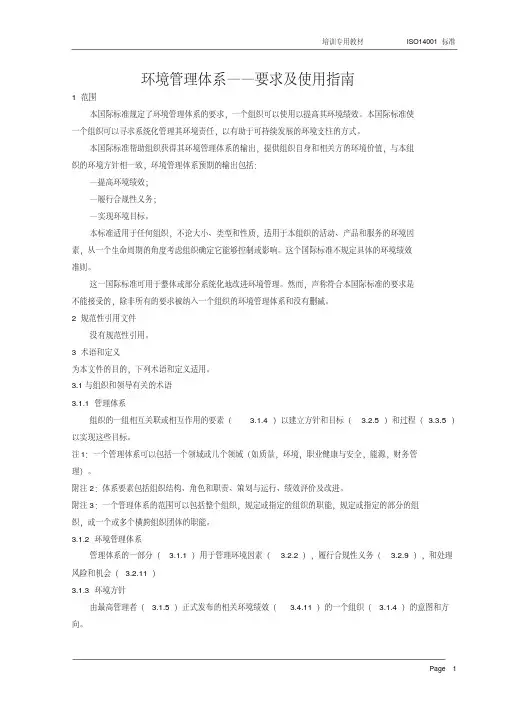
环境管理体系——要求及使用指南1 范围本国际标准规定了环境管理体系的要求,一个组织可以使用以提高其环境绩效。
本国际标准使一个组织可以寻求系统化管理其环境责任,以有助于可持续发展的环境支柱的方式。
本国际标准帮助组织获得其环境管理体系的输出,提供组织自身和相关方的环境价值,与本组织的环境方针相一致,环境管理体系预期的输出包括:—提高环境绩效;—履行合规性义务;—实现环境目标。
本标准适用于任何组织,不论大小、类型和性质,适用于本组织的活动、产品和服务的环境因素,从一个生命周期的角度考虑组织确定它能够控制或影响。
这个国际标准不规定具体的环境绩效准则。
这一国际标准可用于整体或部分系统化地改进环境管理。
然而,声称符合本国际标准的要求是不能接受的,除非所有的要求被纳入一个组织的环境管理体系和没有删减。
2 规范性引用文件没有规范性引用。
3 术语和定义为本文件的目的,下列术语和定义适用。
3.1与组织和领导有关的术语3.1.1管理体系组织的一组相互关联或相互作用的要素( 3.1.4)以建立方针和目标( 3.2.5)和过程( 3.3.5)以实现这些目标。
注1:一个管理体系可以包括一个领域或几个领域(如质量,环境,职业健康与安全,能源,财务管理)。
附注2:体系要素包括组织结构、角色和职责、策划与运行、绩效评价及改进。
附注3:一个管理体系的范围可以包括整个组织,规定或指定的组织的职能,规定或指定的部分的组织,或一个或多个横跨组织团体的职能。
3.1.2环境管理体系管理体系的一部分( 3.1.1)用于管理环境因素( 3.2.2),履行合规性义务( 3.2.9),和处理风险和机会( 3.2.11)3.1.3环境方针由最高管理者( 3.1.5)正式发布的相关环境绩效( 3.4.11)的一个组织( 3.1.4)的意图和方向。
3.1.4组织为了实现其目标( 3.2.5)有自己的职能和职责、权限和关系的人或群体。
注1:组织的概念包括但不局限于单一的贸易商,公司,社团,企业,当权者,合伙企业,慈善机关或事业单位,或部分或组合,是否股份制或不是,公共的或私有的。
ISO14001:2015环境管理体系标准(FDIS)引言0.1背景达到一个平衡的环境,社会和经济被认为是基本满足现代人的需求又不损害后代人满足其需求的能力。
可持续发展作为一个目标是通过平衡可持续发展的三大支柱。
社会对可持续发展、透明度和问责的期望已经从环境污染、资源利用效率低下、废物管理不当、气候变化、生态系统退化和生物多样性丧失等方面发展了越来越严格的立法,对环境造成了越来越大的压力。
这使得环境管理组织采用一种系统化的方法通过实施环境管理体系,目的是促进环境可持续发展的支柱。
0.2环境管理体系的目的本标准的目的是为组织提供一个框架,来保护环境和应对不断变化的环境条件与社会经济平衡的需要。
它指定要求,使一个组织能够实现预期的结果集的环境管理体系。
一个系统的环境管理方法,可以为高层管理人员提供信息,来建立长期的成功和创建选有助于可持续发展的:——保护环境预防或减轻不良环境影响;——减轻潜在的不利环境条件对组织的影响;——协助组织实现合规义务;——提高环境绩效;——控制或影响组织的产品和服务的设计、制造、分布式、消费和处理,通过使用生命周期的角度来看,可以防止环境影响生命周期内无意中被转移到别的地方;——实现财务和运营效益的同时,还实现环保的替代品,加强组织的市场地位;——环境信息交流有关利害关系方。
本国际标准,就像其他国际标准,并不打算增加或改变一个组织的法律要求。
0.3成功因素环境管理体系的成功取决于承诺所有级别和功能的组织,由最高管理层组织利用机会来预防或减轻不良环境影响,提高有益的环境影响,尤其是那些具有战略和竞争的影响。
高层管理可以有效地解决其风险和机遇,将环境管理融入到组织的业务流程、战略方向和决策,使他们与其他业务优先级,将环境管理融入其整体管理系统。
示范的成功实现本国际标准可以用来向利害关系方保证一个有效的环境管理体系。
采用本标准本身并不能保证最优环境的结果。
本国际标准的应用可以不同,从一个组织到另一个组织的关联。
Environmental management systems-- Requirements withguidance for use环境管理体系要求及使用指南ISO14001:2015目录引言 (4)1.范围 (6)2规范性引用文件 (6)3术语和定义 (6)3.1组织和领导力相关的术语 (6)3.2 策划相关的术语 (7)3.3 支持和运行相关的术语 (8)3.4 绩效评价和改进相关的术语 (8)4组织的情境 (9)4.1理解组织及其情境 (9)4.2理解相关方的需求和期望 (9)4.3确定环境管理体系的范围 (9)4.4环境管理体系 (9)5领导力 (10)5.1领导力及承诺 (10)5.2环境方针 (10)5.3组织的角色、职责及权限 (10)6策划 (10)6.1应对风险和机会的措施 (10)6.1.1总则 (10)6.1.2环境因素 (11)6.1.3合规义务 (11)6.1.4措施的策划 (11)6.2环境目标及实现策划 (11)6.2.1环境目标 (11)6.2.2实现环境目标的措施策划 (11)7支持 (12)7.1资源 (12)7.2能力 (12)7.3意识 (12)7.4沟通 (12)7.4.1总则 (12)7.4.2内部沟通 (12)7.4.3外部沟通 (12)7.5文件化信息 (12)7.5.1总则 (12)7.5.2创建和更新 (13)7.5.3文件化信息的控制 (13)8运行 (13)8.1运行策划及控制 (13)8.2应急准备和响应 (13)9绩效评价 (14)9.1监视、测量、分析和评价 (14)9.1.1总则 (14)9.1.2合规性评价 (14)9.2内部审核 (14)9.2.1总则 (14)9.2.2内部审核方案 (14)9.3管理评审 (14)10改进 (15)10.1总则 (15)10.2不符合与纠正措施 (15)10.3持续改进 (15)引言0.1 背景为了即能满足当代的需求而又不损害满足后代需求的能力,考虑实现环境、社会和经济之间的平衡是必需的。
环境管理体系——要求及使用指南1 范围本国际标准规定了环境管理体系的要求,一个组织可以使用以提高其环境绩效。
本国际标准使一个组织可以寻求系统化管理其环境责任,以有助于可持续发展的环境支柱的方式。
本国际标准帮助组织获得其环境管理体系的输出,提供组织自身和相关方的环境价值,与本组织的环境方针相一致,环境管理体系预期的输出包括:—提高环境绩效;—履行合规性义务;—实现环境目标。
本标准适用于任何组织,不论大小、类型和性质,适用于本组织的活动、产品和服务的环境因素,从一个生命周期的角度考虑组织确定它能够控制或影响。
这个国际标准不规定具体的环境绩效准则。
这一国际标准可用于整体或部分系统化地改进环境管理。
然而,声称符合本国际标准的要求是不能接受的,除非所有的要求被纳入一个组织的环境管理体系和没有删减。
2 规范性引用文件没有规范性引用。
3 术语和定义为本文件的目的,下列术语和定义适用。
3.1与组织和领导有关的术语3.1.1管理体系组织的一组相互关联或相互作用的要素( 3.1.4)以建立方针和目标( 3.2.5)和过程( 3.3.5)以实现这些目标。
注1:一个管理体系可以包括一个领域或几个领域(如质量,环境,职业健康与安全,能源,财务管理)。
附注2:体系要素包括组织结构、角色和职责、策划与运行、绩效评价及改进。
附注3:一个管理体系的范围可以包括整个组织,规定或指定的组织的职能,规定或指定的部分的组织,或一个或多个横跨组织团体的职能。
3.1.2环境管理体系管理体系的一部分( 3.1.1)用于管理环境因素( 3.2.2),履行合规性义务( 3.2.9),和处理风险和机会( 3.2.11)3.1.3环境方针由最高管理者( 3.1.5)正式发布的相关环境绩效( 3.4.11)的一个组织( 3.1.4)的意图和方向。
3.1.4组织为了实现其目标( 3.2.5)有自己的职能和职责、权限和关系的人或群体。
注1:组织的概念包括但不局限于单一的贸易商,公司,社团,企业,当权者,合伙企业,慈善机关或事业单位,或部分或组合,是否股份制或不是,公共的或私有的。
ISO14001-2015环境手册目录第1 章概述1.1 颁布令1.2 公司简介1.3 管理者代表任命书1.4 环境手册的管理第2章管理体系范围第3章手册引用文件、术语和定义3.1 引用标准文件3.2 术语和定义第4章组织的背景4.1理解组织及其所处的环境4.2 理解相关方的需求和期望4.3确定管理体系的范围4.4管理体系及其过程第5章领导作用5.1 领导和承诺5.2 环境方针5.3 组织的岗位、职责和权限第6章质量环境管理体系策划6.1 应对风险和机遇的措施6.1.1 总则6.1.2 环境因素6.1.3 合规义务6.1.4 措施的策划6.2 环境目标及其实现策划6.2.1 环境目标6.2.2 实现环境目标措施的策划第7章支持7.1 资源7.2 能力7.3 意识7.4 信息交流7.4.1 总则7.4.2 内部信息交流7.4.3 外部信息交流7.5 文件信息7.5.1 总则7.5.2 创建和更新7.5.3 文件信息控制第8章运作8.1 运行策划和控制8.2 应急准备和响应第9章绩效评价9.1 监视、测量、分析和评价9.1.1 总则9.1.2 合规性评价9.2 内部审核9.2.1 总则9.2.2 内部审核方案9.3 管理评审第10章改进10.1 总则10.2 不符合和纠正措施10.3 持续改进1.1环境手册颁布令环境手册是本公司从事与环境管理有关的活动中必须共同遵守的纲领性文件,是公司的基本法规之一,必须严格遵守,以确保公司环境管理体系的正常运行,实现质量环境管理目标,促使公司环境管理工作得到持续改进与不断发展。
环境手册由管理者代表负责组织编写、并经总经理批准发布,是我公司环境管理工作的法规性、纲领性文件,用以统一、协调全公司的质量环境管理活动,使其基于ISO14001-2015标准要求,符合本公司产品、服务和活动中的实际情况,能指导我公司环境管理工作。
现决定正式颁布实施。
公司全体员工必须认真学习,严格按一体化《环境手册》规定的标准贯彻实施。
ISO14001-2015-环境管理体系--要求和应⽤指南ISO14001/FDIS:2015环境管理体系——要求和应⽤指南介绍0.1背景可持续发展要求经济、社会、环境的平衡。
这也是当代社会的主题。
因为各种环境问题,逐步进化出了可持续发展、透明和承担责任的社会期望。
所以企业需要进⾏系统化环境管理,以对可持续发展做出贡献。
0.2环境管理体系的⽬标提供⼀个系统框架来保护环境,对环境状况做出反应,使其与经济社会的需求保持⼀致。
通过⼀系列规范化的要求,帮助企业达成环境管理的预期⽬标。
通过环境管理的系统⽅法使最⾼管理层获得持续的成功,并通过如下⽅法实现可持续发展。
●保护环境,预防或者减少不利环境影响●减轻潜在的对环境条件和组织本⾝的不利影响●帮助组织实现符合性义务●⽤⽣命周期的观点控制或者影响与组织的产品、服务相关的设计、⽣产、分配、消耗、处置等过程,以便预防不利环境影响。
否则,现实中很容易发⽣偏离●通过实施正确的环境选项,实现经济效益,加强市场地位与相关⽅交流环境信息标准不额外增加组织法律责任。
0.3成功因素所有层级的承诺,尤其最⾼管理层。
组织可以充分利⽤机会预防或者减轻不利环境影响,提升有利的环境影响。
尤其是从市场竞争和战略发展⾓度考虑。
最⾼管理层可以通过把环境管理整合进商业过程、战略规划,并将环境风险和机遇与经营重点摆在同等地位,将环境管理组织构架整合进全⾯管理体系中,对组织的风险和机遇进⾏有效的管理。
可以向相关⽅展⽰⼀个成功的环境管理体系。
标准未规定最优的结果,标准具有灵活性和适应性。
环境管理体系复杂程度根据组织不同(环境影响、符合性义务、范围、组织状况)⽽变化。
0.4PDCA组织的背景情况内部和外部的问题相关⽅的期0.5标准内容本标准准守ISO 组织的要求及标准格式。
这些要求包括ISO 标准中更⾼等级的结构要求、核⼼内容的⼀致性、核⼼定义术语⼀致等,以⽅便标准之间的整合。
标准不设定特异于其他⼏个体系的特殊要求。
2015版环境管理体系要求及使用指南标准目录1.范围2.规范性引用文件3.术语和定义4.组织所处的环境4.1理解组织及其所处环境4.2理解相关方的需求和期望4.3确定环境管理体系的范围4.4环境管理体系5.领导作用5.1领导作用与承诺5.2环境方针5.3组织的岗位、职责和权限6.策划6.1应对风险和机遇的措施6.1.1总则6.1.2环境因素6.1.3合规义务6.1.4措施的策划6.2环境目标及其实现环境目标的策划6.2.1环境目标6.2.2实现环境目标措施的策划7.支持7.1资源7.2能力7.3意识7.4沟通7.4.1总则7.4.2内部沟通7.4.3外部沟通7.5形成文件的信息7.5.1总则7.5.2创建和更新7.5.3形成文件的信息的控制8.运行8.1运行策划和控制8.2应急准备和响应9.绩效评价9.1监视、测量、分析和评价9.1.1总则9.1.2合规性评价9.2内部审核9.2.1总则9.2.2内部审核方案9.3管理评审10.改进10.1总则10.2不符合与纠正措施10.3持续改进4组织环境4.1理解组织及其环境组织应确定与其目标相关、并影响其实现环境管理体系预期结果的能力的外部和内部因素。
这些因素应包括受组织影响的或能够影响组织的环境条件。
4.2理解相关方的需求和期望组织应确定:a)与环境管理体系有关的相关方;b)这些相关方的有关需求和期望(即要求);c)这些需求和期望中哪些会成为其合规义务。
4.3确定环境管理体系的范围组织应确定环境管理体系的边界和适用性,以界定其范围。
确定范围时组织应考虑:a) 4.1中提及的外部和内部因素;b) 4.2中提及的合规义务;c) 组织的单元、职能和物理边界;d) 组织的活动、产品和服务;e) 组织实施控制与施加影响的权限和能力。
范围一经确定,在该范围内组织的所有活动、产品和服务均须纳入环境管理体系。
应保持体系范围的形成文件的信息,并可为相关方获取。
4.4环境管理体系为实现包括提升环境绩效在内的预期结果,组织应根据本标准的要求建立实施、保持并持续改进环境管理体系,包括所需的过程及其相互作用。
组织在建立和保持环境管理体系时,应考虑在4.1和4.2中所获得的知识。
5领导作用5.1领导作用和承诺最高管理者应通过以下方式证实对环境管理体系的领导作用和承诺。
a)对环境管理体系的有效性承担责任;b)确保建立环境方针和环境目标,并与组织的战略方向和所处的环境相一致;c)确保将环境管理体系要求融入组织的业务过程;d)确保可获得环境管理体系所需的资源;e)就有效的环境管理和符合环境管理体系要求的重要性进行沟通;f)确保环境管理体系实现其预期结果;g)指导和支持员工对环境管理体系的有效性做出贡献;h)促进持续改进;i)支持其他相关管理者在其负责的领域展示其领导作用。
注:本标准中所提及的“业务”可从广义上理解为涉及组织存在目的非常重要的那些活动。
5.2环境方针最高管理者应在确定的环境管理体系范围内建立、实施并保持环境方针,环境方针应:a)适合于组织的宗旨和所处的环境,包括其活动、产品和服务的性质、规模和环境影响;b)为制定环境目标提供框架;c)包括一项或多项保护环境的承诺,其中包括污染预防其他与组织所处环境有关的特殊承诺。
注:保护环境的其他特殊承诺可包括资源的可持续利用、适应和减缓气候变化、保护生物多样性和生态系统。
d)包括履行其合规义务的承诺;e)包括持续改进环境管理体系以提高环境绩效的承诺。
环境方针应:---保持形成文件的信息;---在组织内得到沟通;---可为相关方获取。
5.3组织的岗位、职责和权限最高管理者应确保在组织内部分配并沟通相关岗位的职责和权限。
最高管理者应对下列事项分配职责及权限:a)确保环境管理体系符合本标准的要求;b)向最高管理者汇报环境管理体系的绩效,包括环境绩效。
6策划6.1应对风险和机遇的措施6.1.1总则组织应建立、实施并保持满足6.1.1至6.1.4中的要求所需的过程。
策划环境管理体系时,组织应考虑:a) 4.1所提及的因素;b) 4.2.所提及的要求;c)其环境管理体系的范围;并且,确定与环境因素、合规义务以及以往在4.1和4.2中识别的其他问题和要求相关的、需要应对的风险和机遇,以:---确保环境管理体系能够实现其预期结果;----预防或减少非预期结果,包括影响组织的潜在的外部环境条件;----实现持续改进;组织应确定其环境管理体系范围内潜在紧急状况,包括可能具有环境影响的情况。
组织应保持下述有关的形成文件的信息:----需要应对的风险和机遇;----足以确信6.1.1至6.1.4中所需的过程已按策划的安排得到实施。
6.1.2环境因素在确定的环境管理体系的范围内,组织应从生命周期观点考虑,确定其活动、产品和服务中能够控制和能够施加影响的环境因素及相关的环境影响。
确定环境因素时,组织须考虑:a)变化,包括已计划的或新的开发,新的或修改的活动、产品和服务;b)异常情况和可合理预见的紧急情况。
组织应依据以建立的准则,确定具有或可能具有重大环境影响的因素,即重要环因素。
适当时,组织应在各层次和职能间沟通其重要环境因素。
组织应保持下述的形成文件的信息:----环境因素及相关的环境影响;----用于确定重要环境因素的准则;----重要环境因素。
注:重要环境因素能导致与有害环境影响(威胁)或有益环境影响(机会)相关的风险和机遇。
6.1.3合规义务组织应:a)确定并可获取与其环境因素有关的合规性义务;b)确定如何将这些合规性义务应用于组织;c)在建立、实施、保持和持续改进其环境管理体系时,对这些合规义务加以考虑。
组织应保持其合规性义务的形成文件的信息。
注:合规性义务可能会给组织带来风险和机遇。
6.1.4策划措施组织应策划:a)采取措施以管理其:1)重要环境因素;2)合规性义务;3)6.1.1中识别的风险和机遇;b)如何:1)将这些措施融入并实施于环境管理体系过程(见6.2,第7条,第8条和9.1),或其他业务过程;2)评价这些措施的有效性(见9.1)。
当策划这些措施时,组织应考虑其可先技术方案、财务、运行和经营要求。
6.2环境目标及其实现的策划6.2.1环境目标组织应针对其相关职能和层次建立环境目标,此时须考虑组织的重要环境因素及相关的合规性义务,并考虑其风险和机遇。
环境目标应:a)与环境方针一致;b)可测量(可行时);c)得到监视;d)得到沟通;e)适时更新。
组织应保持环境目标的形成文件的信息。
6.2.2策划实现环境目标措施策划如何实现环境目标时,组织应确定:a)要做什么;b)需要哪些资源;c)由谁负责;d)何时完成;e)如何评价结果,包括用于监视可测量的环境目标的实现进度所需的指标(见9.1.1)。
组织应考虑如何能将实现环境目标的措施融入其业务过程。
7 支持7.1资源组织应确定并提供建立、实施、保持和持续改进环境管理体系所需的资源。
7.2能力组织应:a)确定在其控制下从事影响环境绩效和影响履行合规性义务能力的工作人员应具备的能力。
b)基于适当的教育、培训或经历,确保这些人员具备所需能力;c)确定与其环境因素和环境管理体系相关的培训要求;d)适当时,采取措施以获得必要的能力,并评价所采取措施的有效性;注:适当措施可包括为在岗人员提供培训、指导或重新委安排工作,或聘用、雇佣能胜任的人员。
组织应保留适当的形成文件的信息作为能力的证据。
7.3 意识组织应确保其在控制下工作的人员意识到:a)环境方针;b)重要环境因素以及与他们的工作相关实际或潜在的环境影响;c)他们对环境管理体系有效性的贡献,包括提高环境绩效的益处;d)不符合环境管理体系要求,包括未履行合规性义务的后果。
7.4 沟通7.4.1总则组织应建立、实施并保持与环境管理体系有关的内、外部沟通所需的过程,包括:a)沟通什么;b)何时沟通;c)与谁沟通;d)如何沟通。
建立沟通过程时,组织应:----必须考虑其合规义务;----确保所交流的环境信息与环境管理体系形成的信息是一致且真实可信。
组织应对其环境管理体系有关的沟通作出回应。
适当时,组织应保留作为其沟通证据的形成文件的信息,7.4.2内部沟通组织应:a) 在其各层次和职能间就环境管理体系相关信息进行内部沟通,适当时,包括环境管理体系的变化;b) 确保沟通过程能够使在其控制下工作的人员对持续改进作出贡献。
7.4.3外部沟通组织应按其建立的沟通过及合规性义务的要求,就环境管理体系的相关信息与外部进行沟通。
7.5形成文件的信息7.5.1总则组织的环境管理体系应包括:a)本标准要求的形成文件的信息;b)组织确定的为确保环境管理体系的有效性所必需的形成文件的信息。
注:不同组织的环境管理体系形成文件的信息的程度可能不同,取决于:----组织的规模及其活动、过程、产品和服务的类型;----证实履行合规性义务的需要;----过程的复杂程度及其相互作用;----在组织控制下工作的人员的能力。
7.5.2创建和更新在创建和更新形成文件的信息时,组织应确保适当的:a)标识和描述(如标题、日期、作者或文献编号);b)格式(如语言、软件版本、图示)和媒介(如纸质的、电子的);c)评审与批准,以爆炸适宜性和充分性。
7.5.3形成文件的信息的控制应对环境管理体系和本标准要求的形成文件的信息应进行控制,以确保:a)在使用处和需要时可获得适用信息;b)形成文件的信息得到充分保护(如防止失密、不当使用或缺失)。
为控制形成文件的信息,适用时,组织应规定和实施下列活动:----分发、访问、检索和使用;----存放和保护,包括保持可读性;----变更的控制(如版本控制);----保留和处置。
组织确定的环境管理体系策划和运行所需的外来形成文件的信息,应得到适当识别和控制。
注:“访问”可能意味着仅允许查阅,或意味着允许查阅并授权修改。
8 运行8.1运行的策划和控制组织应按以下方式建立、实施、控制和保持满足环境管理体系要求以及实施6.1和6.2中规定的措施所需的过程,通过:----建立过程的运行准则;----按照运行准则实施过程控制;注:控制可能包括工程控制和程序控制,控制可按层级实施(如:淘汰、替代、管理),可单独或组合使用。
组织应对已策划的变更进行控制,并对非预期变更的后果予以评审,必要时,采取措施减轻任何不利影响。
组织应确保外包过程得到控制或施加影响。
应在环境管理体系内规定对这些过程实施控制或施加影响的类型与程度。
从生命周期的观点出发,组织应:a)适当时,制定控制措施确保在产品和服务的设计和开发过程中,考虑其生命周期各个阶段的环境要求;b)适当时,确定对采购产品和服务的环境要求;c)与外部供方(包括承包商)沟通相关环境要求;d)考虑是否需要提供与产品和服务的运输或交付、使用、使用后处理和最终处置有关的潜在重大环境影响的信息。